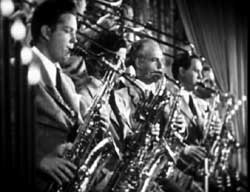 Swing & Sing (1948) is a four-film one-reel home movie advertised by Castle Films as a "Music Album." The components of this film are obviously independent soundies such as Castle frequently lumped together, & individual title cards are provided for each song indicating they are separate films, with only two of the four even having the same stage set.
Swing & Sing (1948) is a four-film one-reel home movie advertised by Castle Films as a "Music Album." The components of this film are obviously independent soundies such as Castle frequently lumped together, & individual title cards are provided for each song indicating they are separate films, with only two of the four even having the same stage set.
Yet these occur in no catalog of soundies that I've encountered, so it may be that these were never distributed to Panoram jukeboxes & were only ever seen on this reel.
The exact dates for the individual films is hard to surmise, but the songs by Rosen & Carter debuted in the musical comedy Sing Another Chorus (1941), & Martha Tilton sung one of them "Dancing in Air") shortly after in Strictly in the Groove (1942).
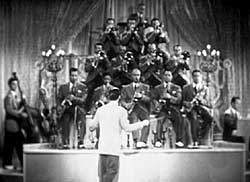 Plus, Will Osborne's orchestra made several Panoram soundies in 1941. The clues are slim but I'd say the individual components all date from 1942 & may even have been directed by Josef Berne who directed the Will Osborne soundies. Plus, Will Osborne's orchestra made several Panoram soundies in 1941. The clues are slim but I'd say the individual components all date from 1942 & may even have been directed by Josef Berne who directed the Will Osborne soundies.
One of the numbers is Dixie, a big swing band arrangement of "wish I were in the land of cotton," opening with a bank of saxophones, then showing bank of trumpets above them, trumbones above them in a bit of a pyramid.
The camera then cuts to a shot further from the stage so as to see the entirety of Will Osborne & His Orchestra in action.
Though mostly a "regular" big band swing arrangement, the trumpet solo then the clarinet solo strive for Dixieland & aren't too bad.
Since the brief piano solo is much more a modern jazz bit neither 40s swing nor Dixieland, the arrangement ends up seeing like a hodgepodge, & even turns into a march before it ends. Best I can say of this one is it doesn't stink.
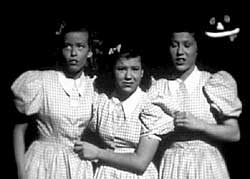 The Boogie Woogie Boogie Man is a rare Halloween theme soundie with the Will Osborne Orchestra backing up the very young Brian Sisters -- Betty, Gwen & Doris -- who start off with the lyrics:
The Boogie Woogie Boogie Man is a rare Halloween theme soundie with the Will Osborne Orchestra backing up the very young Brian Sisters -- Betty, Gwen & Doris -- who start off with the lyrics:
"There's a spook in tinpan alley walking on the piano keys/ He's the jiving ghost who can make the most/ Of his rhythm making tendencies.
"So, better watch out, someone's about/ Hauntin' the town with new kinds of rhythm/ You may meet the boogie woogie boogie man."
The sisters had been a child act & though they're teenagers by the time they appeared in this featurette, they're still dressing like little children. Their harmonies are reminscent of the Andrew Sisters, more commercial than artful.
As they sing the stage goes dark, the girls huddle close, & jack-o-lanterns lower from above to float (or dangle) behind them.
Suddenly a harsh light strikes the stage & gigantic shadows of three dancing witches hover over the girls threateningly. In all, quite a cool bit of film, of a song by Milton Rosen & Everett Carter.
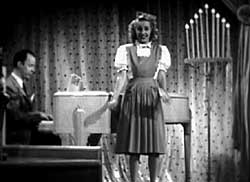 Pretty Martha Tilton, star of film, radio, & recording, is backed by the Will Osborne Orchestra for the bouncy swing number Dancing on Air, again composed by Milton Rosen & Everett Carter.
Pretty Martha Tilton, star of film, radio, & recording, is backed by the Will Osborne Orchestra for the bouncy swing number Dancing on Air, again composed by Milton Rosen & Everett Carter.
"It's funny what love can do/ Gee I'm feeling high/ Head in a cloud, singing out loud, dancing on air./ It's sunny & skies are blue/ Gosh I'd like to fly/ Over the trees, caught in the breeze, dancing on air.
"When he held my hand & whispered dearest/ I jump for joy/ Now you'd hardly know me/ Up her with the earth below me."
It's a pleasant enough song, nothing classic, & "liltin' Tilton" was a decent singer of the era. See also the reviews of some Martha Tilton Soundies.
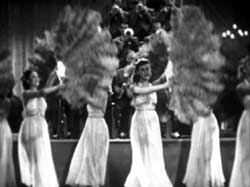 Filmed at the same time as Dixie with the same visual arrangement of the Will Osborne Orchestra "stacked" in a pyramid, Fantasia is a punning title. A skillful but somehow histerically funny chorus line of fandancers come onto stage on ballerina tippy-toes.
Filmed at the same time as Dixie with the same visual arrangement of the Will Osborne Orchestra "stacked" in a pyramid, Fantasia is a punning title. A skillful but somehow histerically funny chorus line of fandancers come onto stage on ballerina tippy-toes.
These are the Aida Broadbent Dancers (they were also known as Aida Broadbent & the Can-Canettes). Aida had been a choreographer on Broadway & for several films between 1940 & 1945, & afterward operated a dance school in Vancouver, Canada.
Today an annual Aida Broadbent Award is given by the Theater Under the Stars' Humphrey School of Musical Theater, honoring those who have excelled in professionalism & performance.
These dancers wear white gowns in emulation of Sally Rand's gown except Sally's would've been more nearly see-through to reveal a silhouette of her body (see Sally's Fan Dance, 1942).
This chorus line of fan-dancers do quite a pleasing bit of choreography, then out stroll a dance couple as we hear a female vocalist take up the lyrics:
"Come & walk with me through a beautiful starlit bower/ Where the blossoms are just the flower of our love./ Walk with me on a wonderful moonlit highway/ As we follow it far to that gay little star above."
We never see who is singing, but it is the voice of Martha Tilton. With the orchestra arranged in their pyramid at back of the stage, this soundie's focus is on the dancers.
The fandancers keep at their art, with the lead dancer doing acrobatic flips in her evening gown, assisted by her partner in tails. The song is pretty good -- actually titled "Walk with Me" -- & the dance routine is completely amazing.
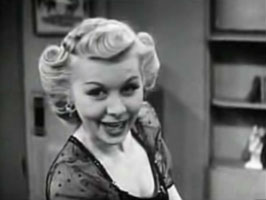 Will Osborne & His Orchestra gets top billing in A Feller Who Plays in the Band (1941), with secondary credit of "featuring vocalist Susan Miller."
Will Osborne & His Orchestra gets top billing in A Feller Who Plays in the Band (1941), with secondary credit of "featuring vocalist Susan Miller."
As filmed, though, it really stars Susan, who is instantly shown in close-up alone on the set, arranged to look like her apartment.
She's a bleach blonde with a commedienne's face, given a pretty ordinary swing song to try to put over: "I wouldn't give that/ For an autocrat/ Or a diplomat/ In a high silk hat/ But oh oh oh/ How I could go/ For a feller who plays in the band."
During the first verse the camera pans backward & reveals Will Osborne in the room with her, playing his clarinet.
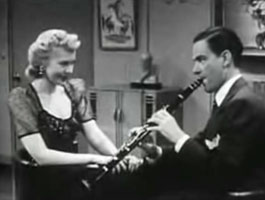 During the instrumental break, in order to add novelty, we don't just watch Will play, but jump-cut to the apartment below. A grumpy looking fellow (William Irving) is trying to sleep despite the blasting through his ceiling. During the instrumental break, in order to add novelty, we don't just watch Will play, but jump-cut to the apartment below. A grumpy looking fellow (William Irving) is trying to sleep despite the blasting through his ceiling.
He reaches for a sleeping potion on his bedstand but it doesn't work so he gets up & paces under the ceiling, looking angrier & angrier. And who can blame him, though we only saw one clarinet being played upstairs, we hear an entire gawdamn orchestra.
The grumpy neighbor storms upstairs to knock on the door. Susan hides her boyfriend Will in a closet, wherein he keeps playing the clarinet, so is quickly found by the grump. And out of the closet comes not only Will, but also, one behind the next, a guy with bass drum plus,string section, piccolo, the whole orchestra including even a white upright piana which roles out with the pianist on the bench.
The joke fully shown, Susan sings the last verse, & the film ends with a Cameo Productions "The End" card.
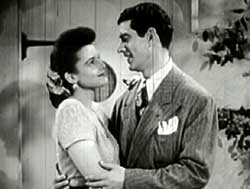 Never was a moniker less apropos than that of Harry Cool who has no charisma on film, though his voice is good enough.
Never was a moniker less apropos than that of Harry Cool who has no charisma on film, though his voice is good enough.
In the soundie My Blue Heaven (1945), he strides into something of a garden setting stiff as a board & looks in a window like a peeping tom. He's got what looks like a newspaper under his arm, as though he expects to be standing there a good long while & might need some reading matter.
The pre-recorded lyrics seem barely to be issuing from his faintly quivering lips: "When the whipporwills call/ And evening is nigh/ I hurry to my blue heaven..." Perhaps he thinks he's lipsyncing with his eyes, as they're blinking like mad.
A woman comes to the window & seems not alarmed so he must not be a peeper after all. He meets this woman at the door, tossing his paper on a bench just outside the house. Note the handkerchief sticking out of his pocket; it has more personality than he does.
The scene shifts to inside the house. He left the newspaper outside. The lyrics inform us this is his wife & they have a baby. The baby looks to be about six years old & not at all happy to be in the film. She's blonde; Harry & his wife both have black hair. I wondered if Harry wouldn't realize the kid couldn't possibly be his.
Wow, Harry actually bobs his head once or twice as he sings the lyrics a second time more speedily than the first time. He's in an easy chair now, so maybe he's starting to feel comfy enough to give his head a couple motions.
Wifey puts the kid on Harry's lap & he starts bouncing his knee up & down. As the crappy number ends Harry tries to kiss his "daughter" but she turns her face away from his bad breath.
I do kind of like this soundie because Harry's discomfort on camera is amusing. But that's kind of a cruel reason to like it. It's included in the Official Films anthology of three soundies Love Songs (1947). The other two numbers are Bob Kennedy's Whispering (1946) & Wendy Bishop's Blue Moon (1946).
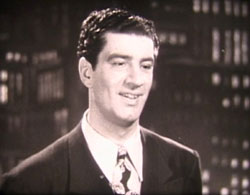 Sweet Lorraine (1945) opens with a close up of a one-name model "McGovern" who was from the famous Conover modeling agency. She has no greater claim to fame than this soundie, but she's a stunner, & is fine casting to be Sweet Lorraine incarnate.
Sweet Lorraine (1945) opens with a close up of a one-name model "McGovern" who was from the famous Conover modeling agency. She has no greater claim to fame than this soundie, but she's a stunner, & is fine casting to be Sweet Lorraine incarnate.
The camera backs up & we see who is singing, Harry Cool who always looks stiff & uncomfortable. We see that he can't even figure out he should be looking at the model at the nearby table while singing these particular lyrics. There's spark in him at all, & the soundie director obviously hoped you'd be looking at McGovern instead.
The song's a great one from the era, though, & Harry isn't a terrible singer. Even his stiffness has a kind of charm once you get used to him. He's weirdly handsome with his Kirk Douglas chin, when you get used to how odd he looks. Girls in the soundie's contrived audience sigh over his crooning.
The setting is a rooftop club, with potted plants & couples at tables. Harry finally sits at the table with Lorraine, lights her cigarette, & continues to make little or no eye-contact with her as she breathes smoke in days when that was considered sexy.
This soundie was included in the Official Films home-movie one-reeler Sweet & Lovely (1947) together with Bob Kennedy singing I'll See You In My Dreams (1946) & Dean Hudson & His Orchestra performing their theme song Moon Over Miami (1947).
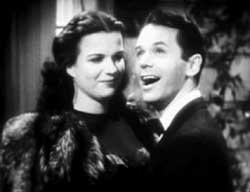 Inconsequential vocalist David Brooks sings to his mink stoled girlfriend:
Inconsequential vocalist David Brooks sings to his mink stoled girlfriend:
"Wouldn't it be a change for you & me to stay at one once in a while/ We cabaret until the break of day I bet we've danced many a mile/ I'd like to see a movie once more/ They don't keep people staying up until four/ Wouldn't it be a pleasant novelty to tumble in early once more."
Such is the introduction to Sleepy Time Gal (1944) as sung by this nondescript Bing Crosbyish crooner, which continues: "Sleep time gal, you're turning night into day/ Sleepy time gal, you've danced the evening away..."
The song's a standard & I suppose it could be sung with greater appeal than this, but as performed by David Brooks it really is a snoozer.
The gal he sings it too is just for decoration & she has the thankless job of just standing there like a grinning retard.
When at length there's a jump-cut to her in the kitchen, we realize she's probably not his girlfriend but his stay-at-home wife; or, rather, he is fantasizing her barefoot in the kitchen:
"You'll learn to cook & to sew/ Once more you'll love it I know/ When you're a stay-at-home, play-at-home, eight o'clock sleepy time gal." How lame is that.
This was included in the Official Films one-reeler Music for Moonlight (1947) together with lovely Lina Romay's Let's Get Lost (1943), plus Apple Blossom Time (1941) featuring the excreble Men & Maids of Melody.
copyright © by Paghat the Ratgirl
|
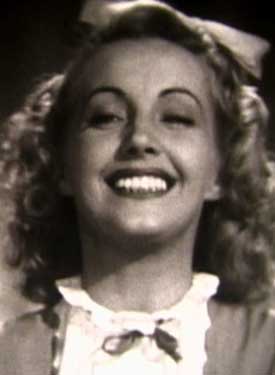

 Plus, Will Osborne's orchestra made several Panoram soundies in 1941. The clues are slim but I'd say the individual components all date from 1942 & may even have been directed by Josef Berne who directed the Will Osborne soundies.
Plus, Will Osborne's orchestra made several Panoram soundies in 1941. The clues are slim but I'd say the individual components all date from 1942 & may even have been directed by Josef Berne who directed the Will Osborne soundies.



 During the instrumental break, in order to add novelty, we don't just watch Will play, but jump-cut to the apartment below. A grumpy looking fellow (William Irving) is trying to sleep despite the blasting through his ceiling.
During the instrumental break, in order to add novelty, we don't just watch Will play, but jump-cut to the apartment below. A grumpy looking fellow (William Irving) is trying to sleep despite the blasting through his ceiling.

